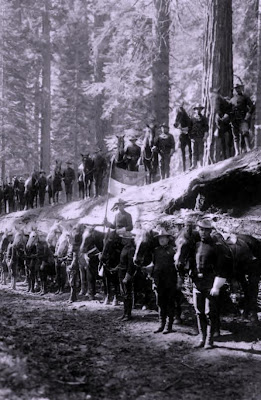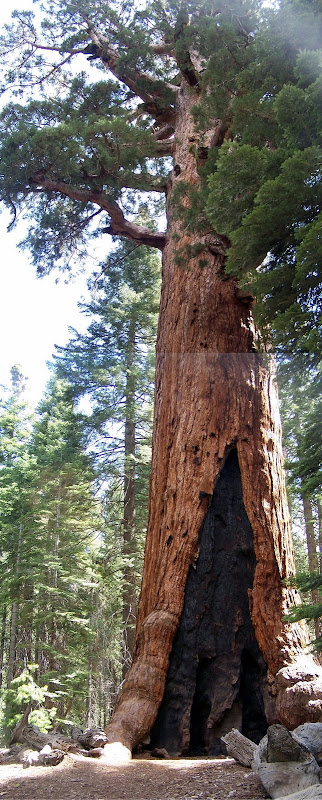Mariposa Grove of Giant Sequoias The Mariposa Grove (Yosemite)  Wednesday, May 21, 2008, 10:00
Wednesday, May 21, 2008, 10:00 100% natural, I had promised! Just after the park's south entrance, turn right onto Mariposa Grove of Big Trees. At 3 km, there is parking. If you want, you can make the journey with us, late in the article. And I hope you do not forget your cameras pan, otherwise you'll like me, collage!
Here we are between 1700 and 1800 meters. The English named the area
Mariposa, referring to the many butterflies found in the hills. But I prefer Now let a ranger of the National Park Service, Jon Kinney, who died in May 1986 to share his wonder at these magnificent trees.
Giant sequoias, Sequoiadendron giganteum
, are not the oldest living organisms. Although some giant sequoias are older than 3000 years of living specimens of the ancient bristlecone pine, Pinus arista
have more than 4600 years old!
Redwoods giants are not the tallest living organisms either. Their cousin coastal yew leaves,
Sequoia sempervirens can reach 115 meters high. These
sequoias of the Sierra not exceed 94 meters, in Mariposa Grove, the largest measuring about 88 meters.
Giant sequoias are not even the largest basal diameter. The Montezuma cypress, Taxodium mucronatum
, Mexico may exceed 15 meters. Basal diameter of the largest giant sequoia is just over 12 meters.
Why these trees while they raise much interest? All simply because in total the giant sequoia is the largest living organism known.

On your right at the entrance to the grove by the main path, is
the Fallen Monarch . Biologists believe that this tree is on land for centuries. The tannic acid in the wood prevents the initial growth of fungi and bacteria, which blocks virtually any decomposition of a redwood felled. This is after leaching of the tannin of the wood by rain and melting snow that decomposition can begin.
Note the roots of this tree. Redwoods have no deep roots, they spread out near the surface to catch water. If they do not usually more than two meters deep, they may extend over 45 meters, providing a stable base for the huge trunk. By staying on the road and trails, visitors minimize soil compaction harmful to these surface roots.
[The photo-cons
The Fallen Monarch and Troop F of the Sixth Cavalry in 1899, gives an order of magnitude.]
along the road above the Fallen Monarch
are many young redwoods, recognizable by their foliage, rounded scales, their conical shape and soft, spongy bark.
Oddly, there are few young redwoods in the forest. Do you know why?
Seed germination of redwood requires three elements: 1) some sunshine, 2) sufficient moisture and 3) a bare mineral soil. Ironically, construction of roads creates an ideal seedbed by opening the floor to sunlight, increasing the moisture on the edges of roads and providing a bare mineral soil on the roadside.
the Bachelor and Three Graces
(the single and the three graces), one often finds redwood cones, egg-shaped. The crown of a giant sequoia adult may be at any time, thousands of green cones. Each cone contains about 200 tiny, flat seeds, of about 1 centimeter long and similar to oatmeal. These female cones grow on the upper branches. To reproduce, the giant sequoia depends on the wind. The late-winter storms produce high winds that carry the pollen from the lower branches of a tree to the branches above the other, allowing pollination of seeds and promotes genetic mixing necessary for sound reproduction.
 The Grizzly Giant
The Grizzly Giant , one of the largest trees of Mariposa Grove, has an estimated age of 1800 years. By approaching the base, look up. The huge branch on the south side measuring about 2 meters in diameter, which is more than the trunk of any tree other than the redwood grove!
But why young redwoods are so rare away from the road? Shortly after the discovery of these trees in a well-intentioned desire to protect them, people started to remove natural fires. Shrubs more tolerant of shade grown rapidly in the undergrowth, reducing sunlight, capturing moisture, and covering the land of their needles and debris. It became impossible for sowing Redwood start.
Only fires caused by lightning reduce the presence of other conifers, remove leaf litter on the floor and leave a thin layer of ash rich in nutrients. In addition, the dry heat of the fire some green sequoia cones adults, producing a shower of fresh seeds on a bed fully prepared. In winter, snow covers the Mariposa Grove. At snowmelt the following spring, sunlight, moisture, fresh seeds, ash and earth combine to create a nursery redwood.
The role of natural fires in reproduction of redwood is understood that since the early 1960s. At that time, the presence of 100 years of forest waste and unburned conifer was a massive fuel load. Under these unnatural conditions, lightning could have caused an intense fire rings could kill the largest trees. To reduce the abnormal amount of fuel and encourage the breeding of giant sequoias, the National Park Service began a series of "burns", deliberately lit and monitored by the rangers in the spring and fall. Once the forest will be returned to a more natural state, these controlled fires should be terminated. Nature will then resume its cycle of fires caused by lightning every seven to twenty years.
At 45 meters beyond the Grizzly Giant
is the California Tunnel Tree
, carved in 1895 to allow the passage of stagecoaches
. Few visitors know that the tunnels were dug in two trees in this grove and that it is the only one still standing. Go walk around a tree!
For your information, the second tree, certainly among the most famous in the world, is the Fallen Wawona Tunnel Tree
. Who knows how many millions of visitors
car crossed the tree in 1881, when digging the tunnel in 1969, when it collapsed under a load of snow record. Weakened by huge hole at its base, he died some 1000 years before its time. But the stories and photos from this gentle giant has been around the world and have undoubtedly contributed to the preservation of his companions.
The trail continues and climbs gently up to 2000 meters. If your heart tells you, and if you have time, please feel free to add your program Mariposa Grove Hiking ...
You will see other remarkable redwoods, including Galen Clark Tree
the name of the person who did so much to protect these redwoods. Clark entered the grove for the first time in 1857. He was so impressed that he spent the rest of his life guiding visitors among these wonders and work for their protection.
In 1864, Abraham Lincoln took a moment during the Civil War to declare Mariposa Grove and Yosemite Valley Reserve protected status for the "use, resort and recreation of the public." Galen Clark lived to see the creation of Yosemite National Park in 1890 and the incorporation of the grove in the park in 1906. With John Muir, Galen Clark played a key role in the preservation of Yosemite. What more natural than a beautiful tree to commemorate his name.
Finally, remember that this is the resistance of redwood fire, diseases, insects and rot, which enables them to become millennia. Therefore preserve this magnificent forest: stay on the roads, and do not pick up cones.
Et .. attention to the torticollis, you are warned! ______________________________________________________________________________
[Source the main text: Mariposa Grove and its giant sequoias , where you will also find a detailed plan]
... and hidden bonus, the book online and in English, but with many illustrations on the site National Park Service: The Giant Sequoia Of The Sierra Nevada
 Departments are deployed progressively. The mayors of 36 000 French municipalities are not equipped for fingerprinting.
Departments are deployed progressively. The mayors of 36 000 French municipalities are not equipped for fingerprinting. 






































